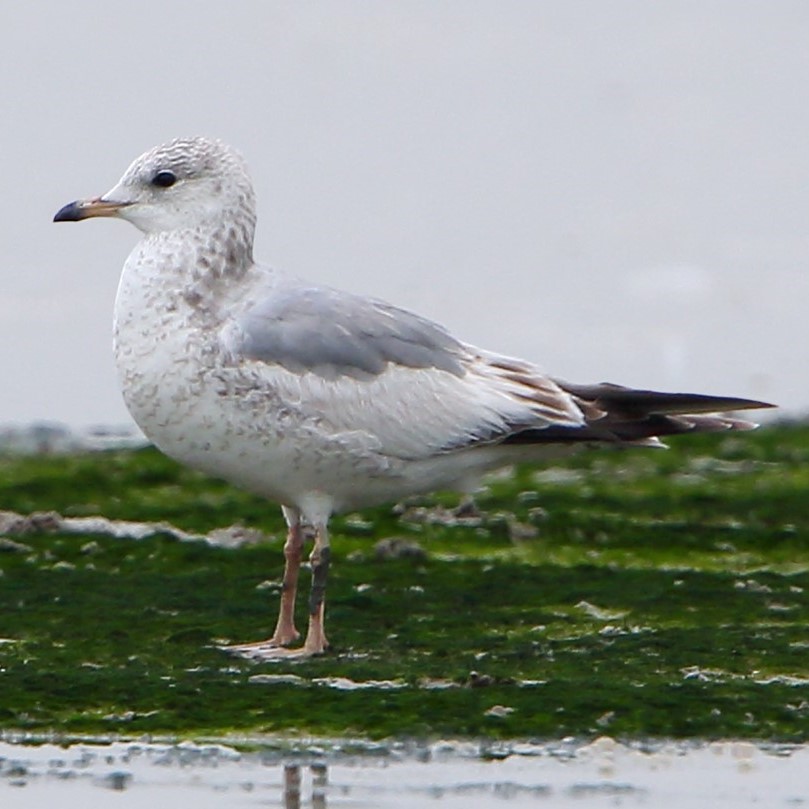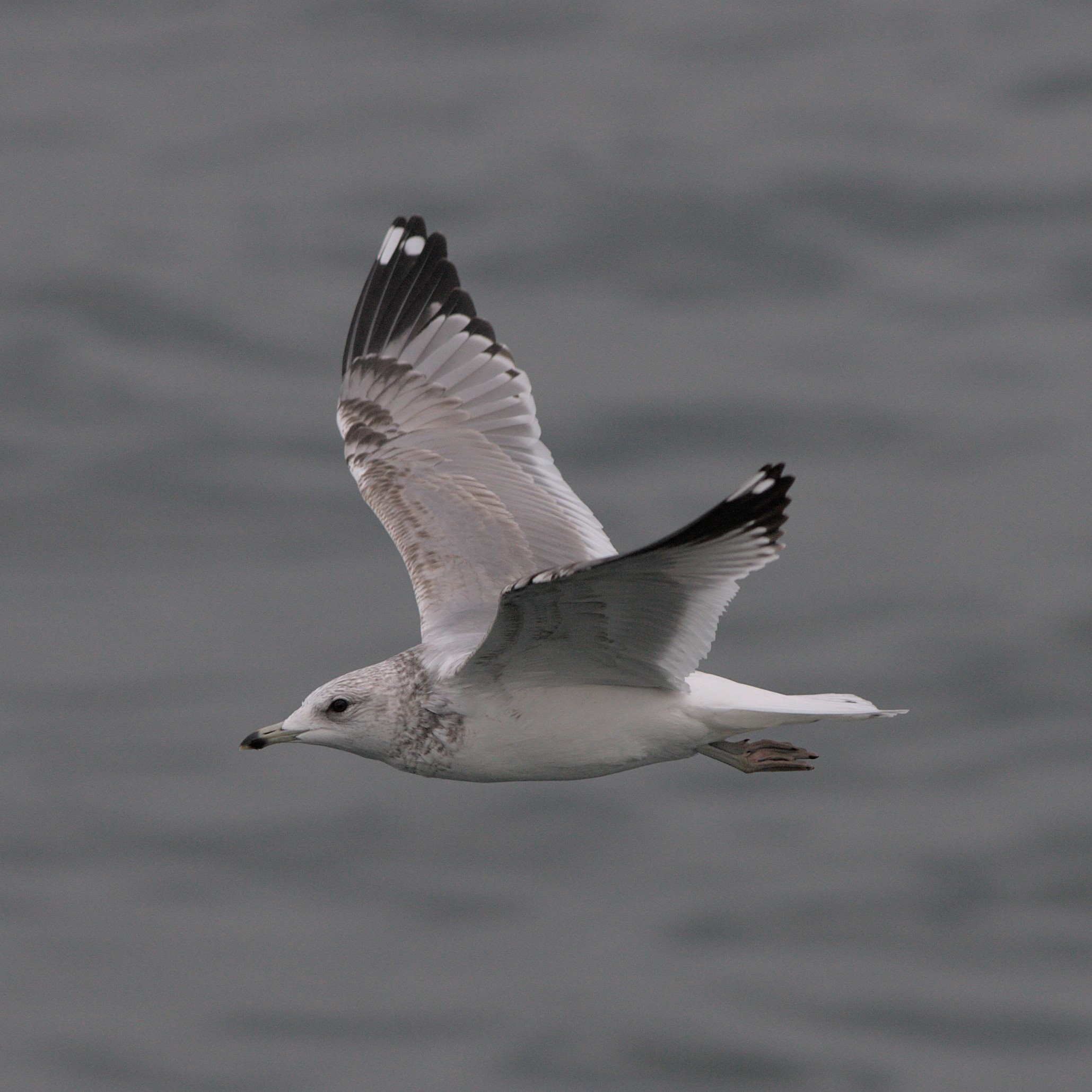Common Gull Larus canus 海鷗
Category I. Scarce winter visitor and passage migrant in spring to Deep Bay.
IDENTIFICATION

Mar. 2014, Michelle and Peter Wong.
Larger than Black-headed Gull but smaller than large gulls from which it also differs by its smaller, thinner bill, more rounded crown, narrower wings and lighter carriage.
Most birds recorded are first-years of the taxon L. c. kamtschatschensis, which have brown mantle and scapulars early in winter and largely grey mantle toward the end; wing coverts are brownish, tertials have dark brown centres, primaries are dark brown, and head and chest are mottled or blotched brownish, occasionally heavily so. Tail has dark band usually with brownish inner webs basally, but occasionally is all-dark.

Jan. 2010, Choshi, Japan. Geoff Carey.
Second-winter birds, which are rarely recorded in HK, have grey mantle, greyish upperwings with some lesser and median coverts brownish, black wing tips and one or two white mirrors on the outer primaries. The bill is dark-tipped and the tail usually has some brownish near the tip.

Mar. 2014, Michelle and Peter Wong.
Separation of L. c. kamtschatschensis from L. c. heinei is not straightforward, and for more detail readers are referred to Adriaens and Gibbins (2016), from which the following is taken. Generally, kamtschatschensis are larger, have a long sloping forehead and a longer and slightly sturdier bill. Most first-year birds are rather coarsely and extensively marked on the head, breast, belly and vent, but have clear, broad and diffuse pale fringes to second-generation scapulars, which vary somewhat in their colour and so look more variegated. Usually, the underwings are off-white with dusky tips and fringes to the feathers, the tail has extensive dark marking basally, the outer web of the outer tail feather is extensively barred or mostly dark and the uppertail coverts are obviously barred.

Mar. 2009, Owen Chiang.
First-year L.c. heinei such as this bird generally has a clean, relatively uniform grey mantle and scapulars, rather white and clean-looking body and underwings, fine streaks on the hind neck, no flank markings, and pale unmarked vent and undertail coverts. Most have rather white tails with little or no dark on the outer tail feather and few or no dark markings on the uppertail coverts; these appear to be key features, if not diagnostic.
Differences among adults and second-years rely on a suite of features that require detailed examination of primaries, secondaries, wing coverts, tertials, head pattern and bare part colour. Reference to Adriaens and Gibbins (2016) is essential.
VOCALISATIONS
Calls are higher-pitched than those of large gulls.
DISTRIBUTION & HABITAT PREFERENCE
Apart from a bird near The Brothers, off north Lantau on 29 January 2013, all records have occurred in Deep Bay, mainly in the gull roost that forms in the first three months of the year.
OCCURRENCE
The previous Avifauna adopted a conservative approach with regard to the subspecific identity of birds recorded in HK. Since then, however, it has become clear that the most numerous taxon is L. c. kamtschatschensis; consequently, all records, unless there is reason to think otherwise, are treated as this.
L. c. kamtschatschensis
Apart from a bird seen during 15-16 November 2013, all records since 1999 have occurred in the period 7 January to 28 March, with slightly higher numbers in the first three weeks of March, indicating passage occurs at this time (Figure 1).
Usually singles are recorded, rarely two birds. Almost all reports are of first-year birds, with only four second-years reported since 1999.
L. c. heinei
There are two records of first-winter birds seen on 15th and 22 March 2009 and 18 January 2021. Although this taxon may be overlooked, it appears to be genuinely rare.
BEHAVIOUR, FORAGING & DIET
No information.
RANGE & SYSTEMATICS
Breeds across the Palearctic from Iceland through northwest Europe, Scandinavia, Russia, northern Kazakhstan, northern Mongolia to the Sea of Okhotsk and Kamchatka; winters largely at sea in the northeast Atlantic, parts of the Mediterranean and east Asia (Moskoff et al. 2021). In China a winter visitor to sea areas of east and south, with small numbers occurring along the Yangtze (Liu and Chen 2020).
Three subspecies are recognised: L. c. kamtschatschensis, which breeds in northeast Siberia, L. c. heinei, which breeds from west Russia to central Siberia and the nominate subspecies, which breeds to the west of there.
CONSERVATION STATUS
IUCN: Least Concern. Population trend unknown.
Figure 1.

Adriaens, P. and C. Gibbins (2016). Identification of the Larus canus complex. Dutch Birding 38: 1-64. Available at: https://www.dutchbirding.nl/journal/38/1
Liu, Y. and Y. H. Chen (eds) (2020). The CNG Field Guide to the Birds of China (in Chinese). Hunan Science and Technology Publication House, Changsha.
Moskoff, W., L. R. Bevier, and P. C. Rasmussen (2021). Common Gull (Larus canus), version 1.1. In Birds of the World (S. M. Billerman, Editor). Cornell Lab of Ornithology, Ithaca, NY, USA. https://doi.org/10.2173/bow.mewgul.01.1

